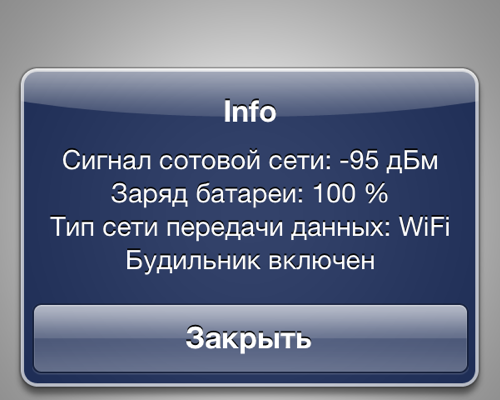Another way to get custom data in iOS
Hello!
I want to show how, without using private APIs (= without using private frameworks / classes / functions), you can collect a variety of data about device usage.
Here is a description of the information you can get:
')
Actually, the essence of the method:
Pros:
Minuses:
If you are interested in how it works, where do constants and descriptions of data structures come from, write in the comments, I will add the article.
I want to show how, without using private APIs (= without using private frameworks / classes / functions), you can collect a variety of data about device usage.

Here is a description of the information you can get:
- Cellular signal strength: RSSI in dBm and relative power in “sticks”
- WiFi signal quality (0 - bad, 4 - good)
- Registration status in the cellular network: presence of SIM, network search
- Type of data network: 2G, 3G, WiFi
- Battery charge accurate to percent (standard tools give 5% accuracy)
- Is “airplane mode” enabled?
- Are various services enabled: alarm clock, Airplay, VPN, call forwarding, Nike +
')
Actually, the essence of the method:
typedef struct { BOOL itemIsEnabled[24]; char timeString[64]; int gsmSignalStrengthRaw; int gsmSignalStrengthBars; char serviceString[100]; char serviceCrossfadeString[100]; char serviceImages[2][100]; char operatorDirectory[1024]; unsigned serviceContentType; int wifiSignalStrengthRaw; int wifiSignalStrengthBars; unsigned dataNetworkType; int batteryCapacity; unsigned batteryState; char batteryDetailString[150]; int bluetoothBatteryCapacity; int thermalColor; unsigned thermalSunlightMode : 1; unsigned slowActivity : 1; unsigned syncActivity : 1; char activityDisplayId[256]; unsigned bluetoothConnected : 1; unsigned displayRawGSMSignal : 1; unsigned displayRawWifiSignal : 1; unsigned locationIconType : 1; } iOS6Data; // retrieve data char *app = (__bridge void *)([UIApplication sharedApplication]); ptrdiff_t providerOffset = 52; char *provider = *(char**)(app + providerOffset); ptrdiff_t iOS6DataOffset = 116; iOS6Data *data = (iOS6Data*)(provider + iOS6DataOffset); Minimum program demonstrating the capabilities of the approach
enum { kTimeItem = 0, kLockItem, kAirplaneItem, kSignalStrengthItem, kServiceItem, kDataNetworkItem, kBatteryItem, kBatteryPercentItem, kNotChargingItem, kBluetoothBatteryItem, kBluetoothItem, kTTYItem, kAlarmItem, kPlusItem, kPlayItem, kLocationItem, kRotationLockItem, kDoubleHeightItem, kAirPlayItem, kVPNItem, kCallForwardItem, kActivityItem, kThermalColorItem }; typedef struct { BOOL itemIsEnabled[24]; char timeString[64]; int gsmSignalStrengthRaw; int gsmSignalStrengthBars; char serviceString[100]; char serviceCrossfadeString[100]; char serviceImages[2][100]; char operatorDirectory[1024]; unsigned serviceContentType; int wifiSignalStrengthRaw; int wifiSignalStrengthBars; unsigned dataNetworkType; int batteryCapacity; unsigned batteryState; char batteryDetailString[150]; int bluetoothBatteryCapacity; int thermalColor; unsigned thermalSunlightMode : 1; unsigned slowActivity : 1; unsigned syncActivity : 1; char activityDisplayId[256]; unsigned bluetoothConnected : 1; unsigned displayRawGSMSignal : 1; unsigned displayRawWifiSignal : 1; unsigned locationIconType : 1; } iOS6Data; void proof_of_concept() { // we need to check runtime before start NSString *systemVersion = [[UIDevice currentDevice] systemVersion] ; NSScanner *scanner = [NSScanner scannerWithString:systemVersion]; int runtime; [scanner scanInt:&runtime]; if (runtime != 6) { NSLog(@" , iOS 6"); UIAlertView *alertView = [[UIAlertView alloc] initWithTitle:@" " message:@" iOS 6." delegate:nil cancelButtonTitle:@"" otherButtonTitles:nil]; [alertView show]; return; } // retrieve data char *app = (__bridge void *)([UIApplication sharedApplication]); ptrdiff_t providerOffset = 52; char *provider = *(char**)(app + providerOffset); ptrdiff_t iOS6DataOffset = 116; iOS6Data *data = (iOS6Data*)(provider + iOS6DataOffset); // usage example NSMutableString *example = [NSMutableString stringWithCapacity:1000]; [example appendFormat: @" : %d \n", data->gsmSignalStrengthRaw ]; [example appendFormat: @" : %@\n", @(data->batteryDetailString)]; switch (data->dataNetworkType) { case 2: [example appendString: @" : 2G\n"]; break; case 3: [example appendString: @" : 3G\n"]; break; case 5: [example appendString: @" : WiFi\n"]; default: break; } if (data->itemIsEnabled[kAlarmItem]) { [example appendString:@" "]; } if (data->itemIsEnabled[kCallForwardItem]) { [example appendString:@" "]; } if (data->itemIsEnabled[kAirplaneItem]) { [example appendString:@" \" \""]; } NSLog(@"%@", example); UIAlertView *alertView = [[UIAlertView alloc] initWithTitle:@"Info" message:example delegate:nil cancelButtonTitle:@"" otherButtonTitles: nil]; [alertView show]; } Pros:
- The data is constantly up to date, the application itself is updating it (UIApplication)
- The solution does not use private APIs.
Minuses:
- The solution is built on iOS runtime, so the structures and constants are different for iOS 5, 6 and 7
- The information obtained is rather superficial, for example, it is impossible to obtain other statistics of the cellular network.
If you are interested in how it works, where do constants and descriptions of data structures come from, write in the comments, I will add the article.
Source: https://habr.com/ru/post/183650/
All Articles